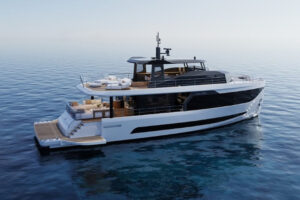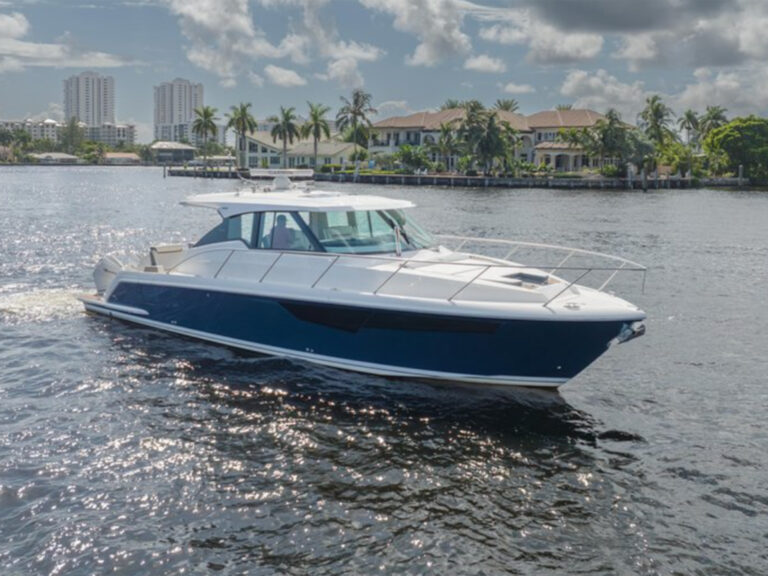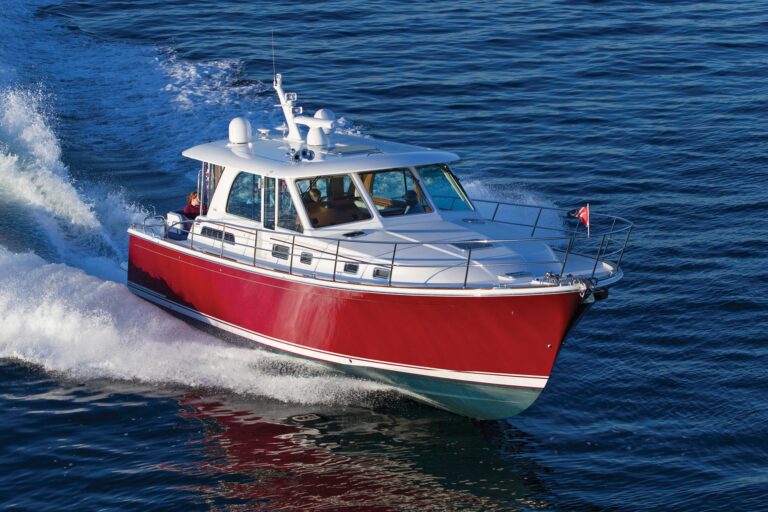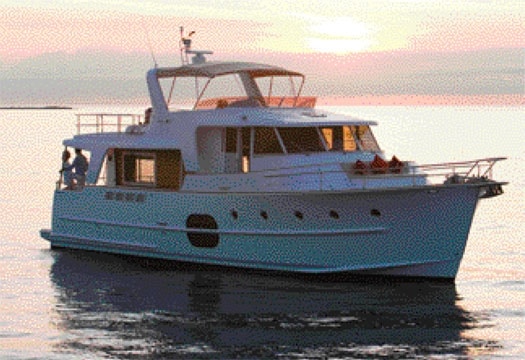
ytgjan09obbenet525.jpg
For Beneteau, the world’s largest sailboat manufacturer, the transition to trawler yachts was a logical progression. The 150-year-old French company had dabbled in powerboats for decades, but the Swift Trawler 52 is clearly aimed at two markets: sailors looking for a “sailorish” powerboat, and skippers looking for a comfortable coastal cruiser.
Sailors, especially those with experience either owning or chartering Beneteaus, will find many familiar design cues, such as the handrails located everywhere you might need to hang on. American sailors will also find a “Euro-ness” about the Swift 52 that may seem foreign at first, but soon feels natural.
Beneteau has already proven its abilities with the Swift Trawler 42, a smaller-and immensely popular-sister boat of which more than 200 have been sold and this Joubert-Nivelt-designed hull is an enlarged version. The exterior has the purposeful look of a patrol craft, in part because of the hard chines and strakes running along the topsides, in part because of the small ports forward, and in part due to the rakish eyebrow above the pilothouse.
The cockpit, like most of the deck, is surrounded by high bulwarks capped by teak rails, although the deck space is reduced by a raised area to port. Two wing doors close off the side decks and are clearly designed to work with an optional cockpit enclosure for some climates.
The salon has a U-shaped settee around a cleverly designed table that spins and unfolds for dining, although anyone sitting aft doesn’t get a backrest. Opposite are two loose chairs that slip into notches between a cabinet holding the pop-up television.
The interior is finished in Alpilignum, a reconstituted wood with multiple veneers of dyed woods. It is absolutely flawless, which is both the good news and the bad news. Real wood has flaws, and some people might mistake this as some version of Formica.
The salon is pleasant, with large windows and a hidden bar in the TV cabinet. The galley opens to the salon, with an interesting shelf that provides extra counter space without requiring larger cabinets. I liked the frosted-glass spatter protection on the after counter, but felt the china cabinet needed a positive latch for a seaway.
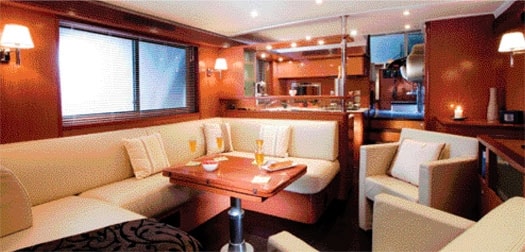
| | |
Having a port that slides open in the galley is not only great for the chef’s view, but a good way to air out cooking smells. Another obvious heritage from Beneteau sailboats are the adjustable pot holders on the three-burner Force 10 cooktop and the deep stainless steel sinks. There is a Vitrifrigo fridge with freezer bins underneath.
Up four steps is the pilothouse, and I was immediately smitten by the large chart table on the port side, complete with an old-fashioned gooseneck lamp and a big chart drawer beneath. The skipper gets a rather industriallooking pedestal chair behind a large leather-wrapped destroyer wheel. The curved black dashboard easily handles a pair of Raymarine E120 screens, with round analog engine gauges for easy scanning within the helmsman’s line of sight, although I can’t imagine why they offset the location of the compass, over on the centerline.
The port corner of the pilothouse gets a raised settee with a two-layered table-cumhandrail that is too wobbly for serious use. Nevertheless, the pilothouse is bright and airy, with good visibility through 180 degrees and sliding aluminum doors to the Portuguese bridge.
A central stairwell leads to the lower deck, with the master stateroom spanning the beam aft. It features a queen-sized berth under a sloping overhead and large double windows on each side that provide a great view for one sprawled on the bed. These are marred by small opening ports for which I can imagine no use: They couldn’t admit enough air to make it worthwhile to sacrifice the window.
Forward, the guest cabin’s V-berth can be converted to a larger berth with a filler cushion that pretty much fills the cabin. Just outside the cabin door is access to the guest head, which is also shared by the third cabin to port.
Our test boat had stacked bunks with a metal ladder to reach the upper berth, although it can be fitted as a single-berth “dressing room” for the master or as an office with desk.
The flying bridge, accessed via stairs from the pilothouse or a steepish ladder from the after deck, is enclosed by bulwarks topped by a venturi windscreen. The fiberglass helm console holds a single Raymarine monitor and abbreviated gauges, and a settee wraps around a fiberglass table to port. I have to credit Beneteau for extremely comfortable seating here: Most builders get the backrest angles all wrong but these were absolutely perfect for long trips.
To starboard is a fiberglass console with wet bar and fridge, although I was surprised by the absence of any provision for a barbecue or grill. A boat deck is aft with an 880-pound-capacity Besenzoni davit that can handle a RIB tender.
I liked the deep and protected side decks and admired the Lofrans windlass with both a wildcat for chain and a warping head which, in combination with warping winches on each corner of the afterdeck, should make boathandling easy for couples. I wasn’t as fond of the low rail around the foredeck, but that’s easily corrected.
A large hatch opens to the lazarette, although access is awkward since there are no handrails for the ladder and I’d hate to try this in a rolling sea.
Construction is typical of production boats, with a polyester resin sandwich of balsa-core above the waterline, and I have to give Beneteau credit for flawless moldwork.
Standard power is a pair of 575-horsepower Volvo Penta D9 diesels in a surprisingly spacious engineroom, with the optional 13.5 kW Onan genset in the lazarette. There is room to move around on the metal flooring to reach the service points. Drip trays are under the oil filters. There were some unfinished plywood shelves that seemed half-hearted and some of the wiring was jumbly, but this was the first boat in North America and Wayne Burdick, Beneteau USA’s president, assures me these and some of my other irks would be corrected. In fact, Burdick has quite successfully transitioned the Beneteau sailing line to production at his South Carolina facility and, with the likelihood of the Swift Trawlers following, I would expect him to fully Americanize these boats.
Underway the 52 slipped along to match her name, topping out at 24.6 knots without fuss, although most owners won’t want to face the two gallons per mile cost unless they’re really late getting home. At more reasonable speeds, such as 10 knots, she has a range of about 800 miles.
She was a bit noisy at the lower helm, but that was clearly due to the carpetless faux teak-and-holly sole, and she needs larger trim tabs to counter the bow rise for visibility from the lower helm. Again, those issues are being addressed.
This French import is likely to find a comfortable niche on this side of the Atlantic and I wouldn’t be surprised to see her outsell her smaller sister. Très bien, Beneteau!
Beneteau USA, (843) 629-5300; www.beneteauusa.com


